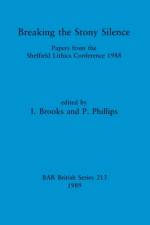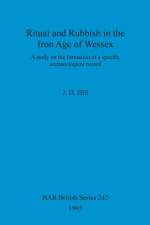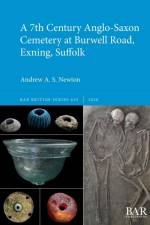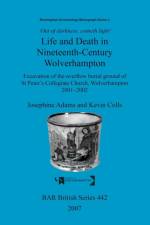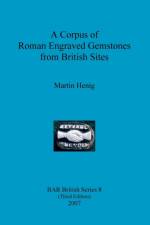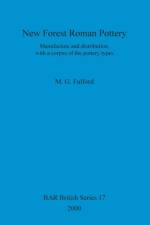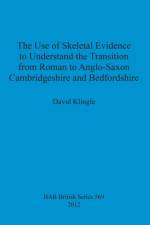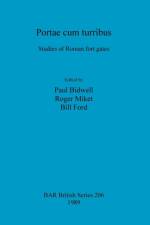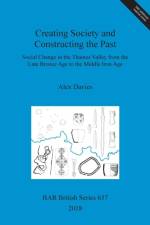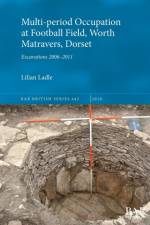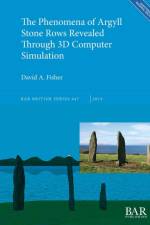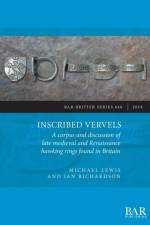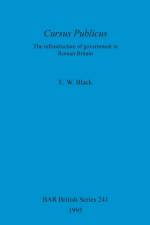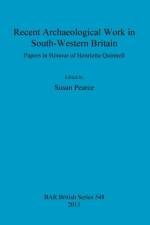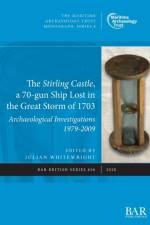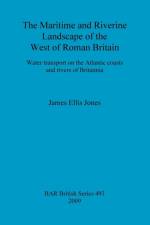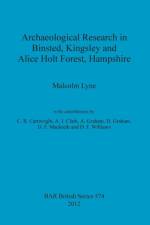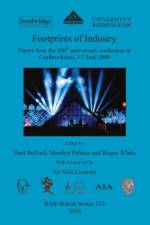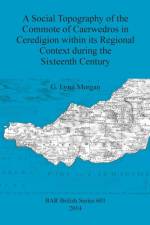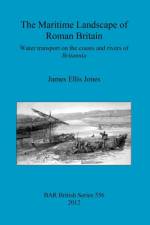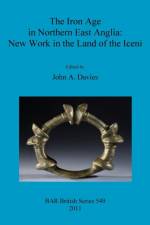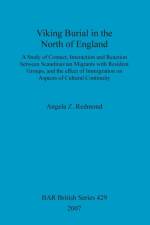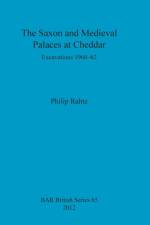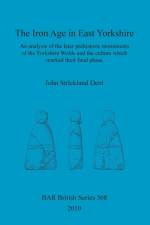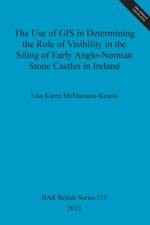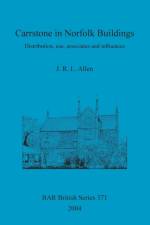Bøger i British Archaeological Reports British Series serien
-
- Bog
- 576,96 kr.
-
- A Study on the formation of a specific archaeological record
670,95 kr. The author has been a familiar speaker at Theoretical Archaeology Group meetings in Britain for a number of years and his general approach must now be familiar to many people. His specific argument that pit deposits usually interpreted as `rubbish' are in fact structured in a meaningful way is sure to be of interest to all archaeologists involved with the investigation of middens or faunal `rubbish' deposits, though taphonomists may remain sceptical. The wider implications for the study of the Iron Age in Britain (especially his historiographical critique of past `culture-historical' approaches) are also stimulating.
- Bog
- 670,95 kr.
-
783,95 kr. The village of Exning in the most westerly part of Suffolk is a small settlement appended to the north-west of the larger town of Newmarket. Despite its modern inferiority to Newmarket, it is understood to have been an important location in the Anglo-Saxon period. Statements in the Liber Eliensis or 'Book of Ely' suggest that St Æthelthryth, or Etheldreda, the daughter of King Anna of East Anglia, who would become Abbess of Ely, was born here. This volume describes the archaeological excavation of the site and the 7th century Anglo-Saxon cemetery that was recorded here. Grave goods present with several of the burials in the cemetery were indicative of high status. Of further note is the similarity of the richest grave at this site with a grave recorded at a cemetery on the Isle of Ely which is considered to have had links with the religious community there.
- Bog
- 783,95 kr.
-
- Excavation of the overflow burial ground of St Peter's Collegiate Church, Wolverhampton 2001-2002
377,95 kr. Excavation of the overflow burial ground of St Peter's Collegiate Church, Wolverhampton 2001-2002Birmingham Archaeology Monograph Series 3Between October 2001 and January 2002, Birmingham University Field Archaeology Unit (now Birmingham Archaeology) carried out archaeological explorations on the overflow burial ground of St Peter's Collegiate Church, Wolverhampton, in the English Midlands. The excavations revealed evidence of activity prior to the use of the area as a burial ground. Two pits and a gully were found, highly truncated, but may be associated with the grounds of a Deanery, which stood in this area during the medieval period. The excavations recorded 152 human burials, dating to the mid-19th century. The majority of the burials were found with scant remains of wooden coffins and had been subject to the intercutting of graves and truncation by later building activity. Seven brick vaults were found, six of which had been emptied, probably during an earlier graveyard clearance. The intact vault and earth-cut burials were found in the south-eastern part of the development site, which appeared not to have been cleared. The preservation of human bone was generally good, despite the high levels of truncation. The sample provided a good opportunity for research into the health and lifestyles of the local population. Anthropological analysis was carried out on 150 skeletons, revealing some striking results. An assessment of the pathology of the skeletons revealed a wide variety of diseases, conditions and trauma, including cases of tuberculosis, osteoarthritis, infectious diseases, syphilis, malignant tumours, and dental diseases. The archaeological evidence, scientific analysis of the skeletal remains, and the documentary research provide an important basis from which to reconstruct the lives and deaths of the people living in central Wolverhampton during the 19th century. The authors hope this project will help to demonstrate the usefulness of such assemblages and the wealth of information that can be gleaned from archaeological, scientific, and documentary analysis.With contributions by Iraia Arabaolaza, Lynne Bevan, Anthea Boylston, Gary Coates, Leonie Driver, Rowena Gale, Annette Hancocks, Emma Hancox, Erica Macey-Bracken, Charlotte Neilson, Paola Ponce, Stephanie Ratkái and Sarah Watt. Illustrations by Nigel Dodds and Kevin Colls.
- Bog
- 377,95 kr.
-
967,96 kr. 'The primary purpose of an engraved gem or ring-bezel, cut in intaglio, was to make an impression upon some fictile material…, which would be understood by the owner of the device, and by his associates, as a personal signature.' So began Martin Henig's original BAR Number 8 from 1978, in the British Series of British Archaeological Reports, a catalogue and study of over 1000 Roman engraved gemstones from the British Isles. Nearly 30 years later comes the third edition of this study, the new Preface to which concludes: 'Over the years I have thought more about gems in relation to other arts and have integrated glyptics into my book on The Art of Roman Britain (1995). Several papers I have written recently have attempted to use gems, like sculpture, painting and bronzes to elucidate general artistic problems. This should be obvious but how many art-historians seem to have the inclination to take gems seriously? At least interest in provincial glyptics seems greater today and that gives me grounds for hope. Important studies are being conducted across the Empire ranging from Belgium … and Portugal …, to Turkey … and Israel. It is for each new generation to reassess the evidence, in the case of our subject with the aid of new techniques, of computing on the one hand and scientific analysis of materials and cutting techniques on the other. In addition the fresh eye of youth is always invaluable. Someone else can often see what should have been obvious to one all the time. (Wolfson College, Oxford. Feast of St Frideswide, 2005)'
- Bog
- 967,96 kr.
-
- Manufacture and distribution, with a corpus of the pottery types
661,96 kr. This book was first published in 1975 and was then reprinted in 2000 with a new preface.
- Bog
- 661,96 kr.
-
1.040,95 kr. The book systematically examines and compares a large sample of burials from the same region, Cambridgeshire and Bedfordshire, in the Roman and Anglo-Saxon periods. A very detailed examination of skeletal material provides specific evidence about this region in the Roman and Anglo-Saxon periods, but also contributes to wider questions of osteological interpretation and political change; specifically the Roman/Anglo-Saxon transition. It explores large issues such as what can be learned from human bones to understand lifestyle and migration. This book will hopefully provide a clear picture of aspects of life in the Roman and Anglo-Saxon periods, which are typically unobservable from other scholarly approaches.
- Bog
- 1.040,95 kr.
-
- Patterns, possibilities and purpose
729,96 kr. In this significant study, Jill Bourne presents the corpus of all 70 surviving Kingston place-names, from Devon to Northumberland, and investigates each one within its historical and landscape context, in an attempt to answer the question, What is a Kingston? She addresses all previous published work on this recurrent place-name, both scholarship with an etymological focus and contextual scholarship which examines the names within their wider context. The core of the work is the hypothesis that names of the type cyninges t¿n or cyning t¿n derive not from independent coinages meaning 'manor/farm/enclosure of a king' in some general sense, or in direct relation to the phrase cyninges t¿n, as it is sometimes assumed in the literature, as an equivalent to villa regia. The study explores connections between Kingstons and the cyninges-t¿ns and villæ regales of the documentary sources; considers the concept and development of early kingship and its possible origins, the laws of the earliest kings, the petty kingdoms, and emergence of the larger kingdoms for which the term Heptarchy was coined (but not used at the time); and pays particular attention to Ancient Wessex, where more than half of the corpus of Kingston names are found, and to the early Anglo-Saxon kingdoms of the Hwicce and Magonsæte, where a further quarter lie.
- Bog
- 729,96 kr.
-
- Studies of Roman fort gates
883,95 kr. First published 1989, this book is a new edition of the proceedings of a seminar held in South Shields (N England) in July 1985 on the architecture of the gates and defences of auxiliary forts in the early principate.
- Bog
- 883,95 kr.
-
- Social Change in the Thames Valley from the Late Bronze Age to the Middle Iron Age
887,95 kr. This book gives a new account of society and social change in the upper and middle Thames Valley from the Late Bronze Age to Middle Iron Age, 1150-100 BC. A model is developed from social anthropological case studies setting out expectations on how societies are structured based on certain material manifestations. Patterns are found within the wide range of types of evidence that are integrated and synthesised. This includes settlements, house forms, metalwork, pottery, human and animal remains, monuments, landscape boundaries and special deposits.The main interpretation offered is that Late Bronze Age societies were fluid and unstructured by either social status differences or lineage identities, whereas Early Iron Age communities were more concerned with ancestral genealogy and inter-generational inheritance. By the Middle Iron Age, communal aspects of ritual practice and material practice were largely replaced by local and household concerns in which smaller groups displayed increasing autonomy from each other.
- Bog
- 887,95 kr.
-
517,95 kr. Black Horse Farm is situated on the Cambridgeshire fen-edge. During the Iron Age and early Romano-British period it occupied a low promontory reaching out into the surrounding wetland. This volume describes the archaeological excavation of the site and the Iron Age settlement and Romano-British activity that was recorded there. The wetland of the fen would have been a prominent part of everyday life at Black Horse Farm and the book examines the way in which the site's inhabitants utilised and exploited it. Fluctuations between dry and damp conditions were also a prominent aspect of life at this marginal location and the later sections examine how the population responded to these conditions. The book examines themes including the organisation of space within the roundhouse, the role of ditches and banks as flood defences versus their social and defensive function, and offers alternative interpretations for some commonly observed features at contemporary sites.With contributions by Beta Analytic Inc., Jane Cowgill, Nina Crummy, Julia E. Cussans, Val Fryer, Andrew Peachey, Ruth Pelling, Carina Phillips, Rob Scaife and Maisie TaylorIllustrations by Kathren Henry, Charlotte Davies and Caroline George
- Bog
- 517,95 kr.
-
- Excavations 2006-2011
1.006,95 kr. This book presents the detailed results of excavations at a small multi-period site in south-east Dorset. The site provided evidence for an Early Neolithic enclosure, a timber-framed, Late Bronze Age roundhouse, Late Bronze Age/Early Iron Age middening activities, Iron Age and Roman settlement and a post-Roman inhumation cemetery. The midden and its associated features and finds are of particular significance, with evidence for deposition and accumulation over several centuries. Other important features include: a Late Iron Age stone-lined pit containing over 100 near-complete pots and a substantial quantity of animal bone, suggesting a large-scale communal gathering and feasting activity; a Roman barn, used as a shale workshop and as a burial place for infants; a 6th- to 8th-century AD cemetery of single, double and triple graves, illuminating the nature of change in burial practices in Dorset at this time; and significant pottery and animal bone assemblages, particularly from the Late Bronze Age/Early Iron Age and Late Iron Age.
- Bog
- 1.006,95 kr.
-
670,95 kr. In this book, David A. Fisher combines methods including Geographic Information Systems (GIS), GPS, computerised three-dimensional modelling and astronomical formulae in order to reconstruct the world as it was seen by the builders of Scottish megalithic sites within the region of Argyll and Mull. These sites have no associated archaeological artifacts that allow us to determine the dates of their construction. Through the employment of these methods, however, the sites' astronomical orientations may be visualised and used to predict a feasible date range for their construction more accurately than has been possible in past research. New discoveries made via computer simulations/animations showing 3D recreations of the sites through the course of a single year, or over millennia (available as a digital download accompanying this book), show that the sites are 800 to 1000 years older than previously stated, and new hypotheses as to how the sites were employed are also suggested. For the first time, the author offers the definitive conclusion that stars formed an important part of megalithic history.
- Bog
- 670,95 kr.
-
- A corpus and discussion of late medieval and Renaissance hawking rings found in Britain
310,95 kr. This book provides a corpus of inscribed hawking rings (vervels) reported Treasure via the Portable Antiquities Scheme over the last twenty years. Since vervels are normally inscribed with information about their owners, they constitute an important social and archaeological record. This information is explored through the corpus, which shows the objects to have been owned predominantly by men of status, particularly in the Stuart period. Also included is a discussion of the development of hawking and the use of vervels, and analysis of their form, function and dating, as well as variations in design. Particularly significant is the information on their distribution, as many inscribed vervels are found in the vicinity of estates owned by the individuals mentioned upon them. This publication thus provides a unique resource to the scholar and to the casual enthusiast.
- Bog
- 310,95 kr.
-
- The Infrastructure of government in Roman Britain
636,95 kr. This book describes and discusses the mansiones of Roman Britain, relating the posts of cursus publicus to the development of roadside settlements. Black makes a detailed examination of particular examples of mansiones through the first to fourth centuries, and in an appendix gives a re-assessment of the Antonine Itinerary, a prime source for the names and locations of roadside settlements.
- Bog
- 636,95 kr.
-
- Papers in Honour of Henrietta Quinnell
564,95 kr. A collection of papers in honour of Henrietta Quinnell.
- Bog
- 564,95 kr.
-
833,95 kr. This book examines the archaeological investigations undertaken between 1979 and 2009 on the wreck of the Stirling Castle a 70-gun third-rate ship of the line, lost on the Goodwin Sands, Kent during the Great Storm of 1703. Included is a history of the warship, a detailed account of archaeological investigations undertaken and the environmental factors impacting the seabed remains. A review of the ship’s construction draws on records of structure remaining on the seabed and recovered material. The artefact collection is considered by material and type. Specialist analysis has enabled greater understanding of ship fittings, weapons, navigation equipment, medical artefacts, food preparation and consumption, clothing and apparel, and life onboard. The volume demonstrates the value of studying dispersed archives from shipwreck excavations and their potential to add considerably to maritime history and archaeology. In this case the examined archaeological records and artefacts from the Stirling Castle offer a compelling insight into the maritime world of the seventeenth and eighteenth centuries from a range of perspectives.
- Bog
- 833,95 kr.
-
- Water transport on the Atlantic coasts and rivers of Britannia
564,95 kr. This is a study of the maritime dimension of transport, to and from the military installations and civilian settlements of the coasts and rivers of the west of Britain, where water was used as the means of conveyance of military and commercial traffic during the Romano-British period. The study gathers together the various strands of evidence and, through systematic analysis, argues that the seas and rivers were a major factor in the Roman supply system and that, whilst the Roman system of roads has received much attention, insufficient consideration has been paid to the role of water transport.
- Bog
- 564,95 kr.
-
1.078,95 kr. This publication deals with the archaeological and documentary evidence for mans' activities in Binsted and Kingsley (Hampshire/Surrey, S. England) during this period between the last Ice Age and the post-medieval period. An interim publication on the Alice Holt Roman potteries contains a short section on the contemporary landscape, accompanied by a rather rudimentary map of the distribution of Roman sites in Binsted and Kingsley parishes between Alton and the Hampshire/Surrey county boundary in north-east Hampshire. The ten years following this publication saw an intensive programme of landscape study in order to explore and understand the changing pattern of human settlement and land utilisation within the area over the last 10000 years or so. Conclusions of the current research reported in this volume are based on seven years of field-walking between 1981 and 1988, as well as some carried out during the early 1970s. All but about half a dozen of the arable fields within the 42 square kilometres of land encompassed by the two parishes were walked and most of the permanent pasture and woodland was also examined. This fieldwork was backed up by the survey of a number of vernacular buildings dating from before AD 1300 to c. AD 1700. Five flights were also carried out between 1981 and 1983 for the purpose of air photography. Excavations were carried out on Alice Holt Roman pottery waste dumps and other sites of all periods in and around the forest.Contributions by C.R. Cartwright, A.J. Clark, A. Graham, D. Graham, D.F. Mackreth and D.F. Williams.
- Bog
- 1.078,95 kr.
-
- Papers from the 300th anniversary conference at Coalbrookdale, 3-7 June 2009
899,96 kr. This volume contains a selection of papers which were presented at the Fe09 Conference in June 2009. The conference was held as part of the 'Coalbrookdale 300' celebrations (Shropshire, England), commemorating the tercentenary of Abraham Darby's success with coke-smelted iron. This momentous event was a truly world-changing moment in human history; and its origins, consequences and wider impacts were the subject of debate and discussion throughout the conference.Foreword by Sir Neil Cossons
- Bog
- 899,96 kr.
-
588,95 kr. The author was inspired to embark on this work by her own sense of Welsh identity and by her surrounding landscape in south-west Ceredigion. In this interdisciplinary research the author defines the historical geography of the commote of Caerwedros by retroactive analysis, relating the area's social topography and structure to the political and economic dynamics of Welsh culture from the later Middle Ages to the 16th century, including its ancient territorial units (tref and rhandir). Part of this is the religious landscape represented by medieval stone churches gracing Ceredigion's coastal rim and the role of important religious houses of founded in the 12th century, especially the Cistercian Abbey of Whitland, whose farms are recorded in charters of the Lord Rhys of Deheubarth. These are mapped within the framework of three granges in the commote. The 15th and 16th centuries saw the emergence of a largely indigenous gentry class as primary controllers of the land and the study tracks the genealogies and family inter-relationships of prominent local families within local community landscapes. Alongside this is an analysis of Welsh place names aimed at increasing our understanding of the social evolution of land ownership and management, within the context of farming communities in the cultural landscape of 16th century south-west Ceredigion.
- Bog
- 588,95 kr.
-
- Water transport on the coasts and rivers of Britannica
661,96 kr. The continuation of the author's fascination with the maritime landscape of Roman Britain (see BAR 493 2009: The Maritime and Riverine Landscape of the West of Roman Britain Water transport on the Atlantic coasts and rivers of Britannia).
- Bog
- 661,96 kr.
-
385,95 kr. This book includes papers from a conference held in Norwich in May 2008 entitled 'Land of the Iceni, the Iron Age of Northern East Anglia'.
- Bog
- 385,95 kr.
-
- A study of Contact, Interaction and Reaction between Scandinavian Migrants with Resident Groups, and the effect of Immigration on Aspects of Cultural Continuity
496,95 kr. 'It is one of the most remarkable aspects of Viking Age England that... there are very few Viking grave- - Richards (2000). This study, by examining all the evidence for Viking settlement, and by looking at burial practices within the entire English social milieu aims to understand why this might be.
- Bog
- 496,95 kr.
-
- Excavations 1960-1962
1.358,96 kr. This re-publication of The Saxon and Medieval Palaces at Cheddar has been prompted by the unavailability of the original, published over a quarter of a century ago. Unlike much historical scholarship, the archaeological report on a site is primary data and therefore needs itself to be read before turning to re-interpretations. It is also appropriate in the context of the recent re-evaluation of the British and Saxon palace of Yeavering, after a similar interval since publication. In the intervening years since publication, This volume has frequently been cited and reviewed, not least as the most extensively-excavated of the royal complexes of the pre-Conquest period.Written by Philip Rahtz, edited by S.M. HirstWith contributions by F. W. Anderson, L. Biek, G. C. Boon, D. Charlesworth, R. H. M. Dolley, E. Eames, J. Evans, A. Garrard, I. H. Goodall, G. W. Green, W. Greenwood, B. Hartley, P. Hembry, E. Higgs, F. Neale, D. P. S. Peacock, R. Powers, J. T. Smith, R. Tylecote, D. Walsh, D. M. Wilson
- Bog
- 1.358,96 kr.
-
457,96 kr. This work is an examination of the transitional period spanning the end of Roman Britain and the beginning of the medieval period, in a small region centred on South Cadbury Castle, Somerset, England. It aims to set this well-known post-Roman settlement in its proper landscape and regional context through a landscape archaeological survey of the, previously poorly studied, hinterlands. Through this method the study moves towards a better understanding of the socio-economic processes effecting social and political change from the 3rd to 10th centuries AD. A multi-disciplinary approach is employed involving cartographic and documentary evidence; extensive geophysical survey and sample excavation revealed a remarkable continuity of land division in the rural landscape from the late prehistoric period to the modern day.
- Bog
- 457,96 kr.
-
- A study of military life from archaeological remains
589,95 kr. This study combines archaeological material from Romano-British forts located in northern Britain with concepts and methods from the New and Processual schools of archaeological theory in order to learn more about the lives of the inhabitants of those forts. The primary goal of the study was the discovery of activity areas within the forts. Secondary goals included the discovery of possible artifact toolkits used in and around the forts and the utilization of information from older excavation reports; it was hoped that computerizing this data would make it more accessible and useful to modern scholars. History and chronology, much of which is based solely upon archaeology, is discussed in Chapter 2 to remind readers of the background information necessary to understand the results of this study. Chapter 3 contains a brief chronological overview of the development of archaeological method and theory concerning northern Roman Britain and corresponding schools of archaeological theory in Britain and the United States. The limitations of the excavation reports used in this study are explained more fully in Chapter 4 and the solutions which were used to circumvent at least partially these limitations are found in Chapters 5 and 6. Chapter 7 shows some aspects of the utility of the database developed for this study by examining the possibility of women living within the forts and the status of those using the various buildings of the forts. Chapter 8 presents the author's conclusions.
- Bog
- 589,95 kr.
-
- An analysis of the later prehistoric monuments of the Yorkshire Wold and the culture which marked their final phase
470,95 kr. Subtitled An analysis of the later prehistoric monuments of the Yorkshire Wolds and the culture which marked their final phase this volume re-examines the evidence for monument and settlement distribution and material culture in the East Yorkshire Wolds.
- Bog
- 470,95 kr.
-
623,95 kr. This work examines the effectiveness of the use of GIS and GIS viewsheds as tools in the study of medieval castles in Ireland. To date, archaeological usage of GIS viewsheds has centred on prehistoric funerary sites. Little work has been done using GIS in relation to medieval castles, a subject and time-frame which is well documented. To date, no work has tested GIS and viewshed analysis across a wide comparative sample of castles. This study uses GIS to examine the visibility of and the views from structures about which much is known. A comparable set of twenty sample castles were taken from a particular period in one social/geographical context, the first century of English lordship in Ireland. Research objectives included exploring the priorities of the first three generations of Anglo-Norman castle builders in Ireland, by determining if there are patterns in site choices. Specifically the project aims to establish whether visibility may have played a role in the siting of these castles.
- Bog
- 623,95 kr.
-
- Distribution, use, associates and influences
564,95 kr. The purpose of this monograph is to examine, primarily from a geological perspective, the distribution and use of indigenous construction materials - carrstone especially but also its competitors together with brick - in the hamlets, villages and towns of north and west Norfolk, part of the fourth largest county in England, without restriction as to period (Roman-modern) or kind of building (cottage, farm, great house, religious, public/community, official).The area embraced roughly coincides with the physiographic sub-regions distinguished as the level, low-lying Fenland with its extensive controlled or artificial drainage, the gently rising Western Escarpment, the North Alluvial Plain along the North Sea coast, the elevated but comparatively level and gently dissected Good Sands, with the Cromer Ridge in the north and east, and the sandy Breckland. A study on such a geographical and temporal scale must, however, be regarded as no more than a reconnaissance, but it brings light to bear on past changes ineconomic and social factors in these parts of the county, will serve as a springboard for detailed, local work in the future, and may interest conservationists and those whose responsibilities include planning, development, and the preservation of the character of the area.
- Bog
- 564,95 kr.

